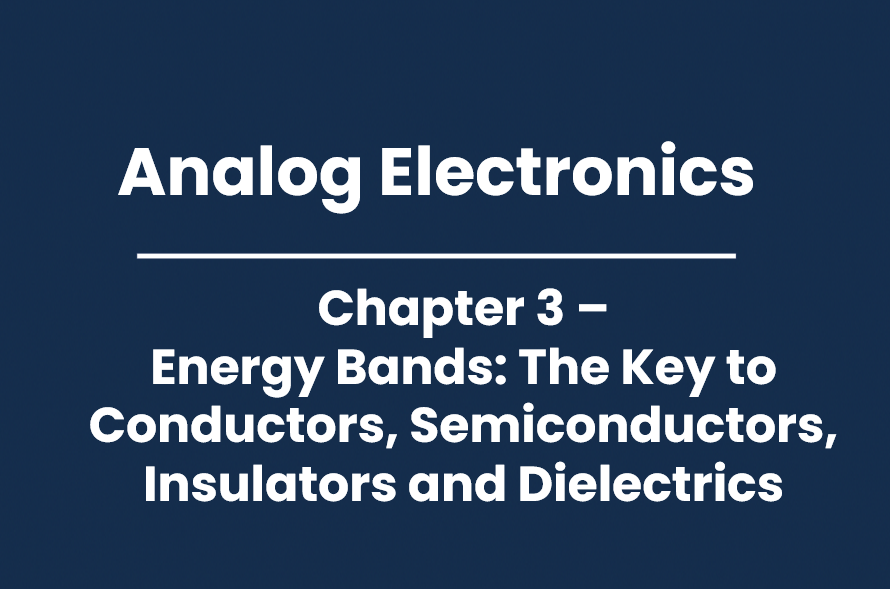
Welcome back to my series on Analog Electronics! In my previous blogs, we explored the fundamental building blocks of matter — atoms, electrons, protons, and neutrons — and how these tiny particles form the foundation of all electronic materials.
Today, we take the next step in understanding how materials conduct electricity by diving into valence bands, conduction bands, and band gaps. These concepts are crucial for explaining why some materials are conductors, semiconductors, insulators, or dielectrics — and how they behave in electronic devices. By the end of this blog, you’ll understand how electrons move, what limits their motion, and why certain materials can carry current while others cannot.
Valence Band
The valence band is the outermost energy band of an atom that contains electrons. The electrons in this band, called valence electrons, are not completely free but can participate in chemical bonding or jump to the conduction band if they gain sufficient energy.
Example: Silicon (Si)
- Atomic Number: 14
- Electron Configuration: 1s² 2s² 2p⁶ 3s² 3p²
- Total Electrons in Outer Shell (n = 3): 4 → These 4 electrons occupy the valence band.
- Valence Electrons: 4 → These determine silicon’s bonding and electrical properties.
In short: For silicon, the valence band contains 4 electrons from the outermost shell, and these are the electrons that can participate in conduction or bonding.
Valence Electrons
Valence electrons occupy the valence band and are located in the outermost shell of an atom. These electrons are critical in determining an element’s bonding behavior, reactivity, and electrical properties.
Conduction Band
The conduction band lies just above the valence band. When a valence electron gains enough energy from an external source — like heat, light, or an electric field — it can move from the valence band into the conduction band.
Once in the conduction band, electrons are free to move within the material and contribute to electrical current. At absolute zero, the conduction band is empty, but as temperature or energy input increases, more electrons make this transition.
Simply put: The conduction band is where electrons become free charge carriers, enabling the conduction of electricity.
Band Gap (Energy Gap)
The band gap (Eg) is the energy difference between the valence band and the conduction band. For an electron to move from the valence band to the conduction band, it must gain energy equal to or greater than Eg.
Let’s explore the band gap for different types of materials:
1. Conductors

In conductors, the valence and conduction bands overlap, or the conduction band is partially filled. There is effectively no forbidden energy gap, so electrons can move freely to the conduction band even at room temperature. This is why metals like copper, silver, and aluminum conduct electricity so easily.
2. Semiconductors

Semiconductors, such as silicon and germanium, have a small band gap — typically between 0.5 and 3 eV. At absolute zero, the conduction band is empty and the valence band is full. At room temperature, or with a small energy input (heat, light, or voltage), electrons can jump to the conduction band.
This property makes semiconductors unique, as their conductivity can be controlled.
Example band gaps:
- Silicon → ~1.1 eV
- Germanium → ~0.7 eV
- Gallium Arsenide → ~1.4 eV
3. Insulators

Insulators, like glass, rubber, and diamond, have a large band gap, usually greater than 3 eV. The energy required for an electron to move from the valence band to the conduction band is far higher than what is available from thermal energy at room temperature.
As a result, electrons cannot become free, and insulators do not conduct electricity under normal conditions.
4. Dielectrics
Dielectrics are materials that do not conduct electricity under normal conditions but can support an electric field. Unlike conductors, electrons in dielectrics are tightly bound and cannot move freely to create current. When an external electric field is applied, charges shift slightly, creating polarization.
This allows dielectrics to store electrical energy, making them essential in devices like capacitors. Common dielectric materials include mica, ceramic, glass, and certain plastics.
Dielectrics typically have a very large band gap > 3 eV same as insulators:
- Valence Band: Fully filled with electrons
- Conduction Band: Completely empty
- Forbidden Energy Gap: Extremely wide, preventing electron movement under normal conditions
In short: Dielectrics do not conduct electricity but act as excellent insulators while storing energy through polarization.
Summary Table
Difference Between Insulators and Dielectrics
- Insulators block unwanted current. Their electrons are tightly bound, and the large band gap prevents conduction. Examples include rubber coatings on wires or glass layers in electrical equipment.
- Dielectrics are a special type of insulator. While they also do not conduct electricity, they can store energy when exposed to an electric field due to polarization. Dielectrics are widely used in capacitors, transformers, and other devices requiring energy storage or insulation.
Key Point: All dielectrics are insulators, but not all insulators are dielectrics. The main difference is that dielectrics actively store energy through polarization, while ordinary insulators only prevent current flow.
Conclusion
Understanding the valence band, conduction band, and band gap gives us a clear picture of how materials behave electrically. We’ve seen how:
- Valence electrons in the outermost shell determine bonding and reactivity.
- Conduction bands allow electrons to move freely, enabling current.
- The band gap explains why conductors, semiconductors, insulators, and dielectrics behave differently.
This knowledge forms the foundation for exploring more complex electronic devices, like diodes, transistors, and operational amplifiers, which we will cover in upcoming blogs.
By connecting the atomic-level view from my previous posts to the electrical behavior of materials, you now have the full picture of how electrons and energy bands shape the world of electronics.

No comments:
Post a Comment